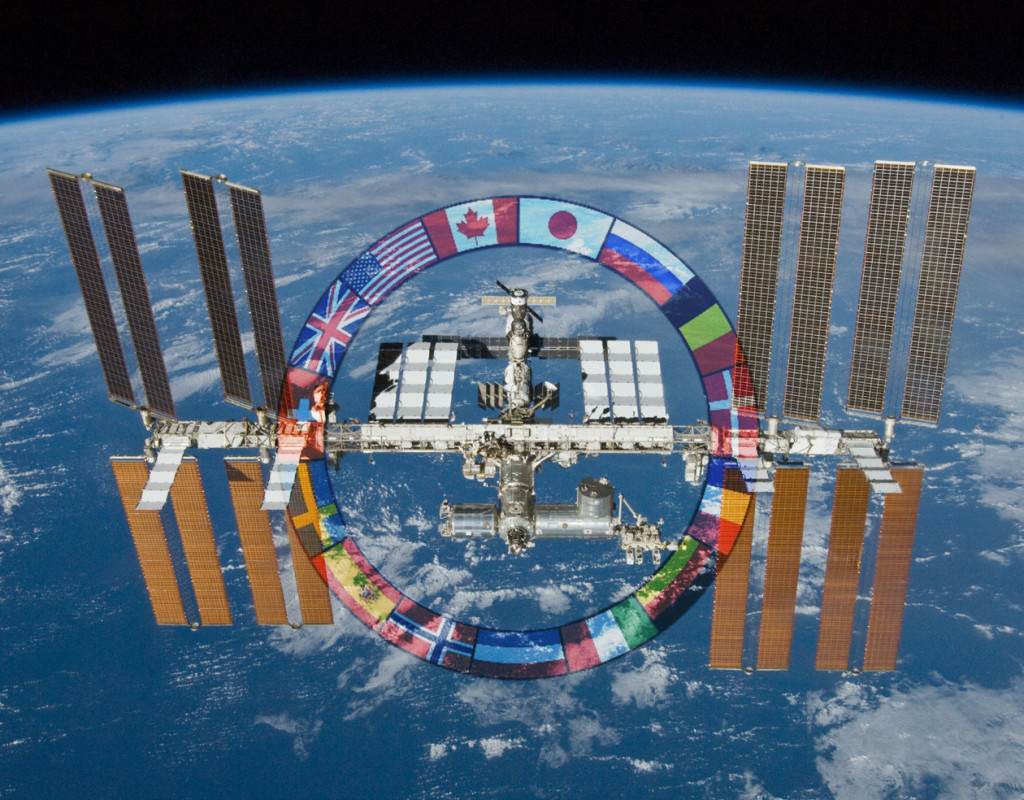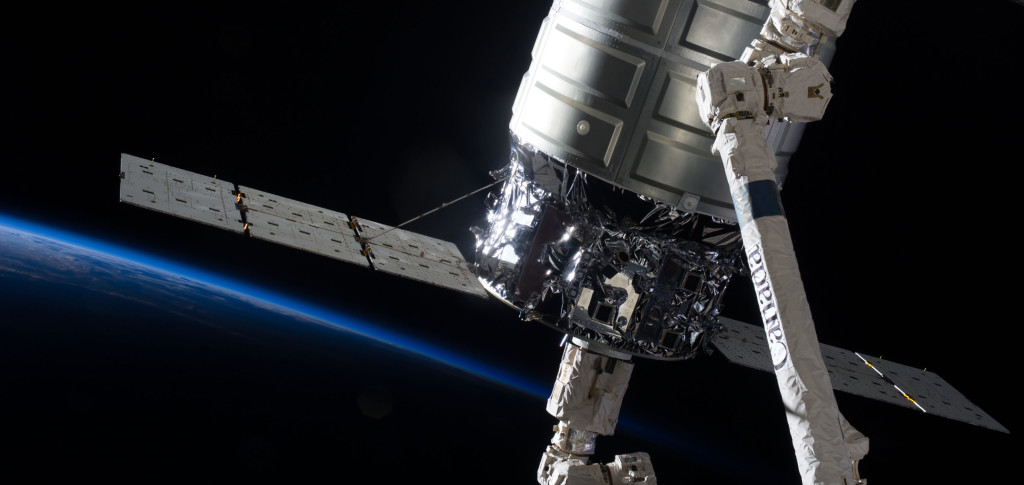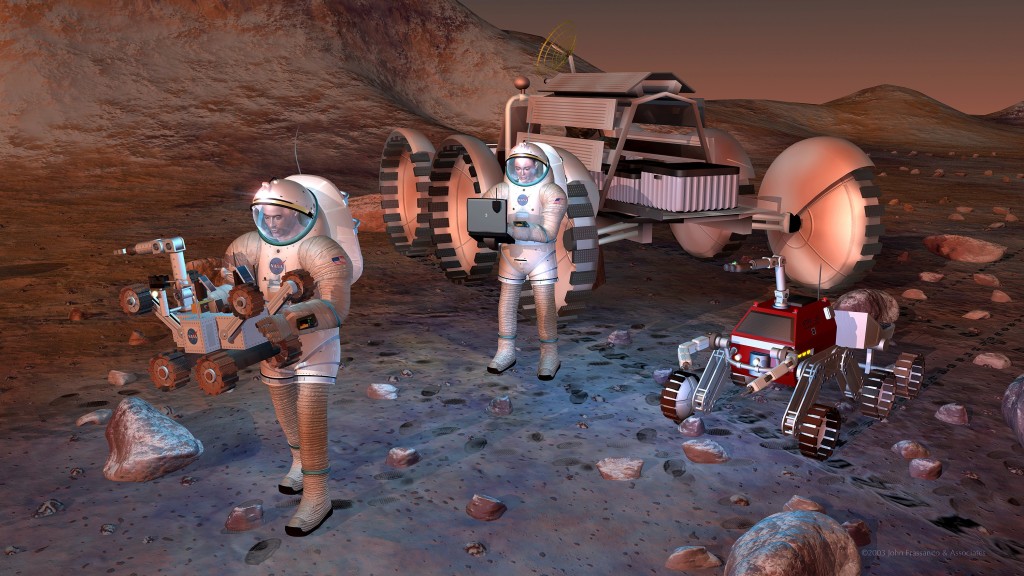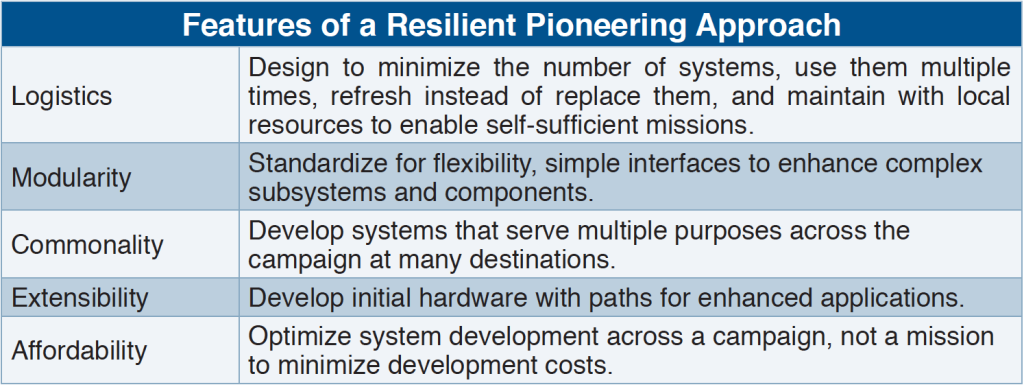
The ISS, with flags of the partner nations.
NASA’s strategy, aligned with the pioneering principles, connects near-term activities and capability development to the journey to Mars and a future with a sustainable human presence in deep space. This strategy strikes a balance between progress toward horizon goals, near-term benefits, and long-term flexibility to budgetary changes, political priorities, new scientific discoveries, technological breakthroughs, and evolving partnerships. The journey to Mars reflects an integrated NASA effort, in collaboration with our partners, to advance from today’s Earth Reliant human spaceflight program through the Proving Ground of cislunar space to an Earth Independent, deep-space capability.
This strategy is a natural evolution of prior decades of space exploration. The era of modern space exploration began with remote observations through early telescopes, providing the knowledge necessary to design and send robotic missions to Earth orbit, planets, moons, comets, and asteroids. NASA’s human spaceflight program has already demonstrated the capability for Earth Reliant human exploration, culminating today with the ISS, where astronauts and supplies are ferried between the station and Earth within hours. Our partners on the ISS, which now include commercial spaceflight ventures, reflecta blossoming worldwide human spaceflight capability for low Earth orbit (LEO). Meanwhile, robotic science missions are scouting resources and characterizing potential destinations for human explorers at far more distant locations within our solar system.
The Path Forward
NASA and our partners are already at Mars, operating with highly effective robotic emissaries in orbit and on the surface. NASA has exploited nearly every opportunity over the past two decades (occurring every 26 months when transit between Earth and Mars is the most efficient) to send orbiters, landers, and rovers to the Red Planet with increasingly complex experiments and sensing systems. Mars orbiters have mapped with high precision the topography of the planet, begun mapping the distribution of water ice below the surface, imaged geologically ancient river deltas, and discovered likely seasonal outflows of salty liquid water in the present.
They have mapped detailed mineral composition in select areas and located suitable landing sites for future robotic and human missions, many with incredible science potential. Robotic landers have demonstrated that the Martian environment could have supported microbial life, as we understand it here on Earth. Additionally, robotic landers have measured radiation in transit and on the surface, and gathered data for defining entry, descent, and landing (EDL) approaches for future human missions. NASA’s Mars 2020 mission will measure atmospheric entry conditions and surface dust, and demonstrate production of oxygen from atmospheric carbon dioxide while selecting and encapsulating samples for potential return to Earth. The journey to Mars requires advanced human and robotic partnerships not imagined at the time of Apollo.

An Orbital ATK Cygnus is berthed to the ISS with 1.6 tons of supplies during the Orb-1 mission in January 2014.
While learning about Mars with robotic science scouts, we are also developing advanced technologies to support human pioneers. NASA is investing in technologies and rapidly prototyping new systems, which benefit both NASA and our industry partners, while minimizing overall costs through innovative partnerships. Focus areas include solar electric propulsion with advanced ion thrusters, habitation systems, nuclear fission for Mars surface power, EDL systems, laser communications for high data rate transmission, deep-space atomic clocks for precise navigation, and many others. NASA will integrate these technologies into pioneering capabilities, providing the tools necessary for the journey to Mars.
Moving from Earth Reliant toward Earth Independent
In the current Earth Reliant phase of human exploration, NASA and our partners are using the ISS in LEO, supported by commercial cargo resupply services and in the near future, commercial crew transportation. The delivery and return of astronauts and cargo to the space station are measured in hours, but any journey to Mars will take many months each way, and early return is not an option. This is an entirely different operating regime, not just for physical access but also for communications with Earth-based teams. Astronauts in deep space must be more self-reliant and spacecraft systems and operations must be more automated to operate safely and productively as we explore beyond LEO.
Cislunar space is the ideal Proving Ground for NASA and its partners to test systems and to practice deep-space operations, such as extravehicular activity (EVAs or spacewalks), and rendezvous and docking prior to committing crew on long missions to Mars.
NASA is focusing on Proving Ground activities in cislunar space, and many of our partners see cislunar space as a step toward human missions to the lunar surface.
These combined activities provide an optimal condition to demonstrate integrated human and robotic missions to build confidence that human missions to Mars can be safely conducted with an Earth Independent mode of operation.
Living and working in space require accepting risk, and the journey is worth the risk. Crews must be protected from the unique hazardous environments of deep space and on the Martian surface. Often, systems will have to operate autonomously or remain dormant for years in preparation for crew. Overcoming these challenges will be essential on the journey to Mars. These technological and operational challenges fall into three categories: transportation, sending humans and cargo through space efficiently, safely, and reliably; working in space, enabling productive operations for crew and robotic systems; and staying healthy, developing habitation systems that provide safe, healthy, and sustainable human exploration. Bridging these three categories are the overarching logistical challenges facing crewed missions lasting up to 1,100 days and exploration campaigns that span decades.
Planning and Implementing a Pioneering Approach
A pioneering approach enables a sustained expansion of human presence into the solar system, rather than a once-in-a-generation expedition. This approach requires us to recognize and address two key challenges. The first challenge is recognition that pioneering space is as much a logistics and supply chain challenge as a technological challenge. Historically, pioneers on Earth could not rely solely on supplies from home to sustain them and neither can the first pioneers on Mars. NASA will have to learn new ways of operating in space, based on self-reliance and increased system reliability; ISRU, including recycling packaging materials and trash; and the ability to design, build, or repair systems with common, modular components.

NASA astronauts exploring Mars on future missions starting perhaps in the 2030’s will require protection from
To enable the journey to Mars, NASA will invest in reusable systems with common components that are modular and extensible to multiple missions to reduce unique developments and the need for spares. Complex tradeoffs between resupply and use of in-situ resources must be first addressed before we achieve Earth Independence. NASA will use missions in the Proving Ground to validate new operational approaches and learn how to balance logistics sent from Earth with the potential benefits and challenges of using local resources. The second challenge is recognition that achieving Earth Independence will take decades and can be impacted by multiple uncertain events.
NASA’s strategy must be flexible and resilient to changes in the priorities of future administrations, the emergence of breakthrough technologies, discovery of new scientific knowledge, fluctuations in funding, and new partnership opportunities. Due to these uncertainties, we must make decisions with incomplete knowledge to ensure continued momentum. However, we can plan for these changes proactively and design for uncertainty to be better positioned when change occurs. We do this by designing a resilient architecture that focuses on critical capabilities across a range of potential missions, investing in technologies that provide large returns, and maximizing flexibility and adaptability through commonality, modularity, and reusability. The journey to Mars is only possible through multi-use, evolvable space infrastructure that minimizes unique developments and associated cost.
Features of a Resilient Pioneering Approach
